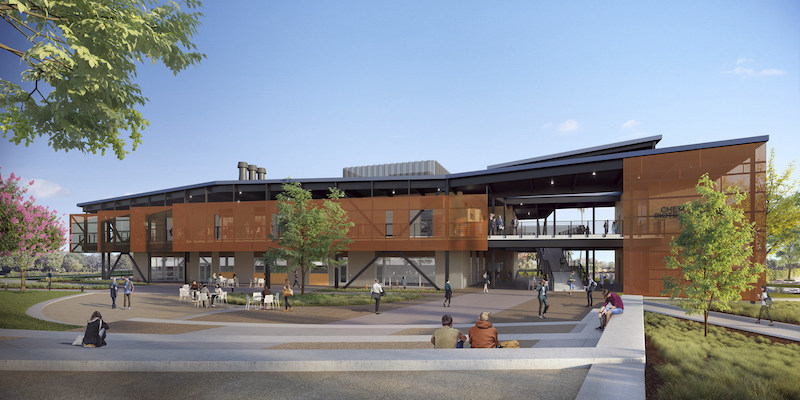MiraCosta Community College is set to receive a new HED-designed Chemistry and Biotechnology laboratory building.
Situated on the northeast quadrant of the Oceanside Campus, the $37.4 million project will include 24,000 sf of STEM instructional space that will feature new chemistry labs and 40-person, flexible classrooms. The building will provide a new, expanded home for the college’s Biotechnology Program.
The project will advance the STEM curriculum to the next level with the help of the facility’s mix of instructional, work, social, and laboratory spaces. The building will be activated through integration with the latest learning technology systems.
SEE ALSO: Lehigh University expands its burgeoning business college
The design takes advantage of the mild Oceanside climate through the incorporation of a ‘big roof’ that provides a weather-protected exterior space for gatherings and interactions. It also will serve as a transition from the building into the quad. Covered and screened porches of varying widths will activate connections to adjoining spaces and provide exterior study and meeting spaces for students.
"This facility takes a 'science on display' approach to stimulating student interest and sharing aspects of the Chemistry and Biotech programs with visitors as well. Large windows and continuous circulation routes allow easy circulation around the building without disturbing classes and labs," said Jennette La Quire, Principal and Project Leader with HED, in a release.
In addition to HED, C.W. Driver is building the project.
Related Stories
| Nov 3, 2014
An ancient former post office in Portland, Ore., provides an even older art college with a new home
About seven years ago, The Pacific Northwest College of Art, the oldest art college in Portland, was evaluating its master plan with an eye towards expanding and upgrading its campus facilities. A board member brought to the attention of the college a nearby 134,000-sf building that had once served as the city’s original post office.
| Oct 16, 2014
Perkins+Will white paper examines alternatives to flame retardant building materials
The white paper includes a list of 193 flame retardants, including 29 discovered in building and household products, 50 found in the indoor environment, and 33 in human blood, milk, and tissues.
| Oct 15, 2014
Harvard launches ‘design-centric’ center for green buildings and cities
The impetus behind Harvard's Center for Green Buildings and Cities is what the design school’s dean, Mohsen Mostafavi, describes as a “rapidly urbanizing global economy,” in which cities are building new structures “on a massive scale.”
| Oct 14, 2014
Proven 6-step approach to treating historic windows
This course provides step-by-step prescriptive advice to architects, engineers, and contractors on when it makes sense to repair or rehabilitate existing windows, and when they should advise their building owner clients to consider replacement.
| Oct 12, 2014
AIA 2030 commitment: Five years on, are we any closer to net-zero?
This year marks the fifth anniversary of the American Institute of Architects’ effort to have architecture firms voluntarily pledge net-zero energy design for all their buildings by 2030.
| Sep 24, 2014
Architecture billings see continued strength, led by institutional sector
On the heels of recording its strongest pace of growth since 2007, there continues to be an increasing level of demand for design services signaled in the latest Architecture Billings Index.
| Sep 22, 2014
4 keys to effective post-occupancy evaluations
Perkins+Will's Janice Barnes covers the four steps that designers should take to create POEs that provide design direction and measure design effectiveness.
| Sep 22, 2014
Sound selections: 12 great choices for ceilings and acoustical walls
From metal mesh panels to concealed-suspension ceilings, here's our roundup of the latest acoustical ceiling and wall products.
| Sep 17, 2014
New hub on campus: Where learning is headed and what it means for the college campus
It seems that the most recent buildings to pop up on college campuses are trying to do more than just support academics. They are acting as hubs for all sorts of on-campus activities, writes Gensler's David Broz.















